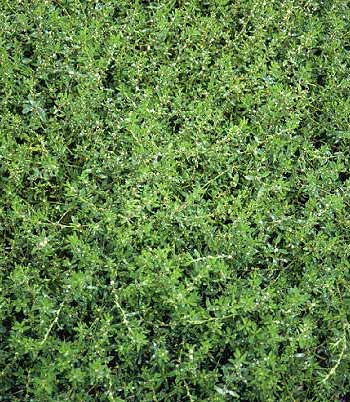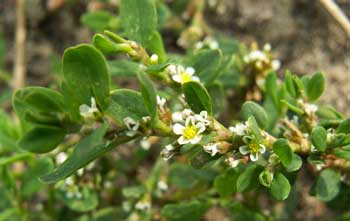Contents:
Common Names | Parts Usually Used | Plant(s) & Culture | Where Found | Medicinal Properties | Biochemical Information
Legends, Myths and Stories | Uses | Formulas or Dosages | Bibliography
Scientific Names

- Polygonum aviculare L.
- Polygonaceae
- Buckwheat family
Common Names
- Beggarweed
- Bird knotgrass
- Birdweed
- Cow grass
- Common knotweed
- Crawlgrass
- Doorweed
- Fen-chieh-ts’ao (Chinese name)
- Goose-grass
- Knotgrass
- Ninety-knot
- Pien-hsu (Chinese name)
- Pigweed
Parts Usually Used
Flowering herb, fresh or dried
Back to Top

Description of Plant(s) and Culture
Knotgrass is an annual plant; the creeping, prostrate stem bears alternate, sessile, lanceolate leaves that narrow at the base, which is covered by brownish, sheathing, knotlike stipules. At the base of each leaf is a jagged, silvery sheath. The axillary flowers, growing all along the stem, are small, green and white or green with pink or purple margins.
Flowering time is from June to October. Blossoms are followed by brown, three-sided fruits in dried petals.
Other varieties: Smartweed or water pepper (P. hydropiper); Water smartweed (P. punctatum); Lady’s thumb, Doorweed, Heartsease, Heartweed, Pinkweed, Redleg, Spotted knotweed (P. persicaria).
Back to Top
Where Found
Found in waste places, roadsides, yards, and cultivated soils all over the world. Also found on shores and around salt marshes. Culpeper tells us that Knotgrass or Knotweed grows in every country of this land.
Back to Top
Medicinal Properties
Astringent, diuretic, hemostatic, vulnerary
Back to Top
Biochemical Information
Volatile oils, silica, mucilage, tannins, and various flavonic derivatives, quercitol, salicylic acid, and kaempferol
Back to Top
Legends, Myths and Stories
Knotgrass has been used in China as a medicinal for lung ailments since the second millennium BC.
A strong tea held in the mouth for 5 minutes relieves toothache and stops bleeding gums. Prolonged use is said to harden loose, spongy gums and make teeth less sensitive. Helps prevent tooth decay.
Back to Top
Uses
Knotweed is recommended for diarrhea, dysentery, and enteritis. Good for bronchitis, whooping cough, jaundice, and lung problems. As a blood coagulant, it is useful for all forms of internal bleeding, including stomach ulcers, snake bites, rheumatism, kills worms, blood purifier, inflammations, swellings, toothache, gangrene, canker sores, filthy ulcers, sores, venereal sores, ear infections, pyelitis, and piles. The fresh juices can be used to stop bleeding from the gums, wounds and from nosebleeds. Knotgrass has been successfully used for cholera infantum, a serious condition with simultaneous vomiting and diarrhea in infants. Taken regularly, the tea or the tincture dissolves gravel and stones.
Back to Top
Formulas or Dosages
Infusion: steep 4 tsp. flowering herb in 1 cup water for 5 minutes. Take 1 to 1 1/2 cups a day, a mouthful at a time, as needed.
Decoction: use 4 tsp. flowering herb in 1 cup water. Take a mouthful at a time, as needed. For stomach and intestinal problems, take 1 to 1 1/2 cups a day; for lung problems 1 1/2 cups a day.
Tincture: take 10-20 drops of knotgrass with 5-20 drops of shave grass in water, three or more times a day.
Back to Top
Bibliography
![]() The Herb Book
The Herb Book, by John Lust, Bantam Books, 666 Fifth Avenue, New York, NY. copyright 1974.
![]() Chinese Medicinal Herbs
Chinese Medicinal Herbs, compiled by Shih-Chen Li, Georgetown Press, San Francisco, California, 1973.
![]() Culpeper’s Complete Herbal & English Physician: Updated With 117 Modern Herbs
Culpeper’s Complete Herbal & English Physician: Updated With 117 Modern Herbs, by Nicholas Culpeper, Meyerbooks, publisher, PO Box 427, Glenwood, Illinois 60425, 1990, (reprint of 1814)
![]() Planetary Herbology
Planetary Herbology, by Michael Tierra, C.A., N.D., O.M.D., Lotus Press, PO Box 325, Twin Lakes. WI 53181., Copyright 1988, published 1992
![]() American Folk Medicine
American Folk Medicine, by Clarence Meyer, Meyerbooks, publisher, PO Box 427, Glenwood, Illinois 60425, 1973
 Secrets of the Chinese Herbalists
Secrets of the Chinese Herbalists, by Richard Lucas, Parker Publishing Company, Inc., West Nyack, NY, 1987.
![]() Webster’s New World Dictionary
Webster’s New World Dictionary, Third College Edition, Victoria Neufeldt, Editor in Chief, New World Dictionaries: A Division of Simon & Schuster, Inc., 15 Columbus Circle, New York, NY 10023
 An Instant Guide to Medicinal Plants
An Instant Guide to Medicinal Plants, by Pamela Forey and Ruth Lindsay, Crescent Books (January 27, 1992).
